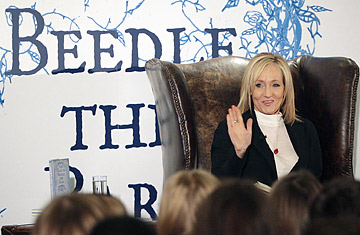
JK Rowling reads excerpts from her new book 'The Tales of Beedle The Bard' to schoolchildren at a tea party at Edinburgh's Parliament Hall.
In Chapter 7 of Harry Potter and the Deathly Hallows Hermione is presented with a copy of a book called The Tales of Beedle the Bard, which Professor Dumbledore left her in his will. (Yes, he's dead. Sorry. Spoiler alert.) Because Hermione, like Harry, grew up in a Muggle family, she's never heard of the Tales, which are decribed as Aesop-like children's stories to be read to little wizarding kids. "Oh come on!" Ron says — he can't quite believe it. "All the old kids' stories are supposed to be Beedle's, aren't they? 'The Fountain of Fair Fortune'...'The Wizard and the Hopping Pot'...'Babbitty Rabbitty and Her Cackling Stump'."
One wonders if at that point Rowling knew she was going to actually be writing those stories. Obsessive planner that she is, she probably did. (See pictures of what J.K. Rowling wrought.)
At any rate, she's written them now — Scholastic has just published the actual Tales of Beedle the Bard, a volume that includes five stories: the three Ron mentions plus "The Tale of the Three Brothers" (which already appeared in full in Deathly Hallows) and "The Warlock's Hairy Heart." Beedle joins Quidditch Through the Ages, Fantastic Beasts and Where to Find Them, and, basically, all the movies as one of the minor but undeniable pleasures of the Potter canon. It's a book of meta-fairy tales — fairy tales for people who already live in a fairy-tale world where dragons and goblins are real. (Read "Why Harry Potter Rules".)
Beedle is, as advertised in Deathly Hallows, a small book — 111 pages, and that's with an introduction, an afterword, triple spacing and margins into which you could fit a Hungarian Horntail. None of the stories in it are bad — I don't think J.K. Rowling knows how to be less than charming in print — but they do vary in quality. The first tale, "The Wizard and the Hopping Pot," is the worst, a grimly heartwarming trifle about how you should be nice to Muggles. "Babbitty Rabbitty and Her Cackling Stump," a variant on the emperor's new clothes, isn't much more successful, though it was a relief to me to learn that the stump in question is a tree stump and not some kind of chortling severed limb.
The collection picks up with "The Warlock's Hairy Heart," a gothic, Poe-like tale about a wizard who uses Dark magic to make himself immune to love. He locks his heart away, literally, Horcrux-style, in a crystal case. By the time he finally goes to recover it he finds that his heart "had grown strange during its long exile, blind and savage in the darkness to which it had been condemned, and its appetites had grown powerful and perverse." Also it had gotten hairy. Rowling doesn't tell us the why of the hair, and no plot points turn on it; it's just there — one of those creepy, evocative details that participate in a logic deeper and stranger than that of plot and moral. (See pictures of Harry Potter's fans around the world.)
The best of the bunch are "The Fountain of Fair Fortune" and "The Tale of Three Brothers." "Fair Fortune" is about three witches and a knight and their quest to reach a magic fountain. "Three Brothers" is, of course, a compressed little gem about Rowling's great themes, love and death. (Though there's one thing I don't get about the story: are we supposed to believe that the Youngest Brother spends his whole life wearing the invisibility cloak? You'd think he'd at least wash it once in a while, at which time Death would swoop down and carry him off.)
There's more to Beedle than the stories: each one comes with commentary by Dumbledore. These sections are the purest pleasure the book has to offer — Dumbledore has always been Rowling's most extravagantly enjoyable voice, and he's in full cry here, wise and funny, taking shots at the Malfoys and at himself with equal enthusiasm. (You won't find him noticeably diminished or enhanced by his posthumously revealed gayness.) Beedle also comes with amateur but elegant illustrations by Rowling — she's not as good an artist as, say, Mary GrandPré, but then again Mary GrandPré isn't J.K. Rowling. It's interesting to get a sense of how the sorceress herself envisions her creations.
I take exception to Rowling's stated theme, expounded in the introduction to Beedle, which is that "magic causes as much trouble as it cures." I'm just not convinced that if I could accio beer my life would not be significantly easier. But that may be because I still haven't absorbed all the wisdom Rowling has to offer. For example, I still find it hard to resign myself to the reality that this may be the last fresh taste of the Potterverse we ever get, outside of fan fiction. In fact you could read the last story, "Three Brothers," not just as a fable about learning how to let go of life, but also about learning how to let go of Rowling's tantalizing, addictive, ecstatic wizarding world. It's not easy. Willingly or unwillingly, we all have to. We just don't have to like it.
